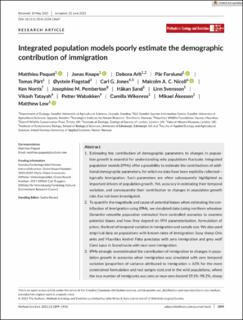Integrated population models poorly estimate the demographic contribution of immigration
Paquet, Matthieu; Knape, Jonas; Arlt, Debora; Forslund, Pär; Pärt, Tomas; Flagstad, Øystein; Jones, Carl; Nicoll, MAC; Norris, K; Pemberton, Josephine M.; Sand, Håkan; Svensson, Linn; Tatayah, Vikash; Wabakken, Petter; Wikenros, Camilla; Åkesson, Mikael; Low, Matthew
Peer reviewed, Journal article
Published version
Permanent lenke
https://hdl.handle.net/11250/3000035Utgivelsesdato
2021Metadata
Vis full innførselSamlinger
Sammendrag
1. Estimating the contribution of demographic parameters to changes in population growth is essential for understanding why populations fluctuate. Integrated population models (IPMs) offer a possibility to estimate the contributions of additional demographic parameters, for which no data have been explicitly collected— typically immigration. Such parameters are often subsequently highlighted as important drivers of population growth. Yet, accuracy in estimating their temporal variation, and consequently their contribution to changes in population growth rate, has not been investigated.
2. To quantify the magnitude and cause of potential biases when estimating the contribution of immigration using IPMs, we simulated data (using northern wheatear Oenanthe oenanthe population estimates) from controlled scenarios to examine potential biases and how they depend on IPM parameterization, formulation of priors, the level of temporal variation in immigration and sample size. We also used empirical data on populations with known rates of immigration: Soay sheep Ovis aries and Mauritius kestrel Falco punctatus with zero immigration and grey wolf Canis lupus in Scandinavia with near-zero immigration.
3. IPMs strongly overestimated the contribution of immigration to changes in population growth in scenarios when immigration was simulated with zero temporal variation (proportion of variance attributed to immigration = 63% for the more constrained formulation and real sample size) and in the wild populations, where the true number of immigrants was zero or near-zero (kestrel 19.1%–98.2%, sheep 4.2%– 36.1% and wolf 84.0%–99.2%). Although the estimation of the contribution of immigration in the simulation study became more accurate with increasing temporal variation and sample size, it was often not possible to distinguish between an accurate estimation from data with high temporal variation versus an overestimation from data with low temporal variation. Unrealistically, large sample sizes may be required to estimate the contribution of immigration well.
4. To minimize the risk of overestimating the contribution of immigration (or any additional parameter) in IPMs, we recommend to: (a) look for evidence of variation in immigration before investigating its contribution to population growth, (b) simulate and model data for comparison to the real data and (c) use explicit data on immigration when possible.

